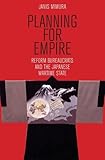Planning for Empire : Reform Bureaucrats and the Japanese Wartime State / Janis A. Mimura.
Material type: TextSeries: Studies of the Weatherhead East Asian Institute, Columbia UniversityPublisher: Ithaca, NY : Cornell University Press, [2011]Copyright date: ©2017Description: 1 online resource (240 p.)Content type:
TextSeries: Studies of the Weatherhead East Asian Institute, Columbia UniversityPublisher: Ithaca, NY : Cornell University Press, [2011]Copyright date: ©2017Description: 1 online resource (240 p.)Content type: - 9780801460852
- Bureaucracy -- Japan -- History
- Civil-military relations -- Japan -- History
- Fascism -- Japan -- History
- Technological innovations -- Japan -- History
- Asian Studies
- Military History
- World War II
- HISTORY / Asia / Japan
- East Asian history
- East Asian studies
- Five Year industrial plans
- Japan's militarization before WW II
- Japanese Wartime State
- Japanese techno-fascism
- Manchukuo history
- Manchukuo puppet state
- Manchukuo
- Tokyo Imperial history
- Tokyo Imperialism
- asian bloc
- asian history
- asian politics
- bureaucracy in japan
- civil military relations in japan
- fascist ideology
- invasion of Manchuria
- japanese colonialism
- japanese empire
- japanese empire building
- japanese fascism
- japanese fascism history
- japanese history
- japanese industry
- japanese invasion of manchuria
- japanese military
- japanese military history
- japanese military policy
- japanese political power
- japanese politics
- japanese studies
- mid-twentieth-century Japan
- military fascism
- military policy
- modern Japanese history
- mori hideoto
- okumura kiwao
- pacific asian history
- technocracy
- wartime Japan
- 952.033 23
- DS888.5 .M546 2016
- online - DeGruyter
| Item type | Current library | Call number | URL | Status | Notes | Barcode | |
|---|---|---|---|---|---|---|---|
 eBook
eBook
|
Biblioteca "Angelicum" Pont. Univ. S.Tommaso d'Aquino Nuvola online | online - DeGruyter (Browse shelf(Opens below)) | Online access | Not for loan (Accesso limitato) | Accesso per gli utenti autorizzati / Access for authorized users | (dgr)9780801460852 |
Frontmatter -- Contents -- Acknowledgments -- Introduction -- 1. Japan’s Wartime Technocrats -- 2. Military Fascism and Manchukuo, 1930–36 -- 3. Bureaucratic Visions of Manchukuo, 1933–39 -- 4. Ideologues of Fascism: Okumura Kiwao and Mōri Hideoto -- 5. The New Order and the Politics of Reform, 1940–41 -- 6. Japan’s Opportunity: Technocratic Strategies for War and Empire, 1941–45 -- Epilogue: From Wartime Techno-Fascism to Postwar Managerialism -- Bibliography -- Index
restricted access online access with authorization star
http://purl.org/coar/access_right/c_16ec
Japan's invasion of Manchuria in September of 1931 initiated a new phase of brutal occupation and warfare in Asia and the Pacific. It forwarded the project of remaking the Japanese state along technocratic and fascistic lines and creating a self-sufficient Asian bloc centered on Japan and its puppet state of Manchukuo. In Planning for Empire, Janis Mimura traces the origins and evolution of this new order and the ideas and policies of its chief architects, the reform bureaucrats. The reform bureaucrats pursued a radical, authoritarian vision of modern Japan in which public and private spheres were fused, ownership and control of capital were separated, and society was ruled by technocrats.Mimura shifts our attention away from reactionary young officers to state planners—reform bureaucrats, total war officers, new zaibatsu leaders, economists, political scientists, engineers, and labor party leaders. She shows how empire building and war mobilization raised the stature and influence of these middle-class professionals by calling forth new government planning agencies, research bureaus, and think tanks to draft Five Year industrial plans, rationalize industry, mobilize the masses, streamline the bureaucracy, and manage big business. Deftly examining the political battles and compromises of Japanese technocrats in their bid for political power and Asian hegemony, Planning for Empire offers a new perspective on Japanese fascism by revealing its modern roots in the close interaction of technology and right-wing ideology.
Mode of access: Internet via World Wide Web.
In English.
Description based on online resource; title from PDF title page (publisher's Web site, viewed 26. Apr 2024)


